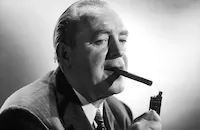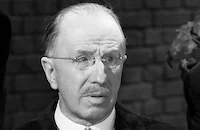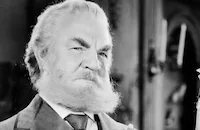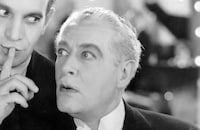American Madness

Brief Synopsis
Cast & Crew
Frank R. Capra
Walter Huston
Pat O'brien
Kay Johnson
Constance Cummings
Gavin Gordon
Film Details
Technical Specs

Synopsis
Union National Bank president Thomas Dickson is chastised by the bank's board of directors, who are upset about Dickson's generous lending practices. The directors also disapprove of Dickson's assertion that the way to end the Depression is to get more money into circulation, thereby enabling businesses to keep going. While the directors' meeting is going on, head cashier Cyril Cluett is threatened by gangster Dude Finlay for not paying his gambling debts. Finlay orders Cluett to help his gang rob the bank that night by making sure the safe is open. Cluett reluctantly agrees, and Finlay tells him to establish an alibi. After Finlay leaves, Dickson's wife Phyllis arrives, and when Dickson's secretary Helen tells her Dickson is busy, Phyllis goes to see Cluett. Because Phyllis is lonely and constantly ignored by her busy husband, Cluett asks her out to dinner that night. She turns him down, but goes with him anyway when Dickson forgets their anniversary and makes plans to be out of town. Head teller Matt Brown, who had seen Cluett's advances toward Phyllis, goes to Cluett's apartment that night to discuss the matter with him, and finds Phyllis, who agrees to leave with Matt. A few moments later, the bank is robbed and the guard killed by Finlay's gang. The next morning the robbery is discovered, and Matt, who is responsible for locking the safe, is arrested. In order to spare Phyllis' reputation, even though it will hurt his fiancée Helen, Matt lies to the police, telling them he was at home when the robbery occurred. His alibi is disproven, and while things grow worse for him, exaggerated reports of the robbery spread until a run on the bank begins. Dickson tries to calm the mob, but as they overwhelm him, the tellers inform him that they will soon run out of money. Dickson appeals to the directors, but they agree to help only if he resigns and gives them an option on his bank stock. He refuses, and while he is calling his friends for help, the police find out about Finlay's visit to Cluett, after which they quickly discover the identity of the robbers and release Matt. Dickson finds out that Phyllis was with Cluett, and, crushed by her apparent betrayal as well as his friends' refusals to aid him, he agrees to the directors' deal. Matt and Helen ask the bank clients into whom Dickson has put so much faith to return the favor and help Dickson by making deposits. As they begin to stream in, their deposits, in addition to Phyllis' pleas, prevent Dickson from committing suicide, and he emerges from his office to take control of the bank. The directors are inspired by the depositors' confidence and invest their own fortunes, which averts disaster. Everything soon returns to normal, and Dickson orders Matt and Helen to get married while he and Phyllis take a second honeymoon.

Director

Frank R. Capra
Cast

Walter Huston

Pat O'brien

Kay Johnson

Constance Cummings

Gavin Gordon

Arthur Hoyt
Robert E. O'connor
Robert Ellis
Jeanne Sorel

Walter Walker

Berton Churchill

Edward Martindel
Edwin Maxwell
Anderson Lawler
Ralph Lewis
Pat O'malley

Sterling Holloway
Harry Holman
Fred Toones
Sarah Edwards
Crew
André Barlatier
Edward Bernds
Frank Capra
Harry Cohn
C. C. Coleman
William Fraker
Stephen Goosson
George Kelly
Robert Riskin
Joseph Walker
Michael Walsh
Maurice Wright

Film Details
Technical Specs

Articles
American Madness
His faith in the power of positive banking strikes his anxiety-prone board of directors as sheer insanity-after all, bankruptcy and insolvency are running roughshod over the United States economy. But there's no stopping Tom, who's "not interested in profits" and thinks of depositors as "friends" rather than customers. Where the directors see dollar signs, Tom sees decent citizens who could "pull this country out of the doldrums" if financial leaders would realize that "character" is the only thing they can really bank on.
Tom obviously embodies the wide-eyed populism found in such Capra films as Mr. Deeds Goes to Town (1936) and Mr. Smith Goes to Washington (1939), which also explore what it means to be a "little guy" in a world where millionaires and power brokers usually pull the strings. In some respects, American Madness amounts to a rigged argument in favor of Capra's most optimistic views. But along the way it shows his nagging awareness of the American dream's darker, madder side.
The movie begins with scenes of the bank's own little guys-a switchboard operator and a group of clerks led by head teller Matt Brown, who laugh and banter as they open the vault and prepare their cash supplies for the day. Things get more dramatic when the directors start plotting to oust Tom and merge with another bank. Then crooks arrive to lean on cashier Cyril Cluett, who owes them a huge gambling debt.
Subplots focus on a couple of office romances, and on Cluett's decision to wriggle off the hook by enabling the mobsters to rob the vault that night. To establish an alibi, he lures Tom's neglected wife to his apartment, causing a colleague to think he's having an affair with her. The heist takes place and exaggerated reports spread through the city, causing a run on the bank. This poses a towering challenge to Tom's business philosophy-he believes in "putting money to work for the country" instead of keeping large reserves on hand-and he'll be sunk if he can't raise the gigantic sums needed to pay off panicky depositors howling for cash. If there's a familiar ring to this, it's because the climax could be a dress rehearsal for similar material in Capra's classic It's a Wonderful Life (1946), released 14 years later.
It's hard to pin down a specific meaning for the title of American Madness, which could refer to the fear-fueled run on the bank's resources, the inflated rumors that touch off the panic, the directors' knee-jerk refusal to recognize Tom's excellent track record, Tom's unquestioning trust in the goodness and competence of average folks, or (most likely) all of the above. It also points to the less-than-logical workings of the human heart, which lead a wrongly accused man to keep quiet about the real burglary culprit so the apparent philandering of Tom's wife won't be revealed. Madness takes many forms, and plenty are on display here.
Credit for American Madness goes to both Capra and screenwriter Robert Riskin, who wrote no fewer than eight Capra pictures during this period, from the Jean Harlow vehicle Platinum Blonde in 1931 to the highly political Meet John Doe in 1941, when creative squabbles ended their partnership. They were an odd couple-the director was a Republican conservative, the writer a Democratic liberal--but their sensibilities mesh beautifully in American Madness, which was evidently inspired by Riskin's admiration for the Bank of America's willingness to take financial risks for the greater good. According to critic Joseph McBride, the screenwriter wanted to "propagandize for the liberal lending policies" that were keeping various underdog businesses afloat-including Columbia Pictures, then one of Hollywood's small but scrappy Poverty Row studios.
Hoping to make maximum impact with its minimal budgets, Columbia encouraged Capra to economize by planning each picture around a few large, complicated sets that framed the action and defined the mood almost as much as the acting and dialogue did. These spacious settings also gave Capra the freedom to experiment with multiple cameras. Capra expert Ray Carney reports that at least two or three cameras, and sometimes six or eight, were rolling away during the most elaborate scenes in his '30s productions. This helps explain the visual energy of American Madness, and the lifelike spontaneity of its performances--especially Walter Huston as the bank president, Kay Johnson as his wife, Pat O'Brien as the chief teller, Constance Cummings as the secretary he's engaged to, and the inimitable Sterling Holloway, making his first talkie appearance as a gabby clerk.
Most critics agree that American Madness is compromised by its Capra-corny elements. Loyal supporters hardly hesitate before storming Tom's bank with bail-out money at the climax. Tom's faith in human nature is so profound that he gave the head-teller job to a crook he caught trying to rob his house. And the screenplay stacks the deck against the hostile directors by letting us know Tom's policies haven't caused a single loss in 25 years, which sounds less like good management than divine intervention. Still, the filmmakers take some bold stances-using camera movement and intercutting to link the bank's self-centered directors with the ruthless gangsters, for instance, anticipating the crime-and-business connections in later melodramas like Force of Evil (1948) and The Godfather Part II (1974).
American Madness seems less urgent now than it must have felt during the Depression era. Noting that it was too topical for comfort in some cities, a review by Pauline Kael observes that it opened in Baltimore the day after a bank panic, and closed less than 48 hours later. But today's audiences should find it engrossing and entertaining-a "good show," as a 1932 critique in The Stage put it, "and hokum only part of the time."
Producer: Harry Cohn
Director: Frank R. Capra
Screenplay: Robert Riskin
Cinematography: Joseph Walker
Film Editing: Maurice Wright
Art Direction: Stephen Goosson
Music: Mischa Bakaleinikoff, Karl Hajos
Cast: Walter Huston (Thomas Dickson), Pat O'Brien (Matt Brown), Kay Johnson (Mrs. Phyllis Dickson), Constance Cummings (Helen), Gavin Gordon (Cyril Cluett), Arthur Hoyt (Ives), Robert E. O'Conner (Inspector), Robert Ellis (Dude Finlay), Jeanne Sorel (Cluett's secretary), Sterling Holloway (Oscar), Fred "Snowflake" Toones (Sam the Shoeshine Man).
BW-77m.
by Mikita Brottman and David Sterritt

American Madness
Quotes
Trivia
Notes
The working titles of this film were Money and Faith. A Film Daily news item lists the following additional cast members, whose participation in the final film has not been confirmed: John Standing and Tom Dugan. Actor Anderson Lawler's name is also spelled Lawlor in contemporary and modern sources. American Madness had a special preview during the annual Columbia convention, held in Atlantic City in May 1932, and its world premiere, attended by prominent bankers and economists, was held in New York on August 4, 1932, the night before the film opened in New York for general audiences.
Although a 1932 Los Angeles Examiner news item noted that the character of Thomas Dickson was loosely based on A. H. Giannini, the chairman of Bank of America's executive committee, Frank Capra stated in a modern source interview that Dickson was based on A. P. Giannini, A. H.'s brother and the founder of Bank of America, whose lending policies based on the character of the applicant were well-known. The Los Angeles Examiner news item also reported that Harry Cohn commissioned the film on A.H. Giannini, and it was originally to have been directed by Allan Dwan. According to modern sources, A. H. Giannini was a partner with Harry and Jack Cohn on the voting trust of Columbia.
This was the first of Capra's films for which Robert Riskin was the sole writer. According to Capra's autobiography, he produced the film's feeling of urgency by speeding up the pace of the acting and editing.
According to information in the MPAA/PCA Collection at the AMPAS Library, American Madness was initially rejected by the Ohio state censor board, but was later approved for showing if the scenes of people mobbing the bank and demanding their money were deleted. In a March 25, 1932 letter to Will H. Hays, the head of the MPPDA, Colonel Jason S. Joy, who was the Director of the Studio Relations Department of the AMPP, made a comment concerning an early script for American Madness and other proposed stories dealing with banks: "The bank stories I think are all right from a policy standpoint and will even do good by helping renew confidence in banking institutions. In fact one of them, a Columbia story tentatively called FAITH ought to be seen by all the bankers themselves for, in script-form at least, it is a strong preachment of principles I know you thoroughly believe in, namely enough confidence by bankers in human nature to allow them to take leadership and help cure these screwy times." After the film was released, A. H. Giannini wrote to Harry Cohn and stated: "I believe that this photoplay, which should be exploited by the leading theatres of this country, will do more than any other single agency to stop runs on banks which are started by false or malicious rumors." Joy sent this letter to various censor boards and exhibitors to advertise the film.















